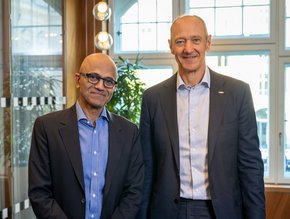What does it mean to be a digital brand?

There are a number of definitions for what constitutes a digital brand. In this roundtable, leading experts look at the difference between digitally native companies and how traditional companies are becoming digital. Business Chief also gains insight into what it means to be a digital brand in today’s world, as well as the ways in which companies can drive the most value out of their digital brand strategy.
Those participating in the roundtable include:
- JP: Jesko Perrey, Senior Partner at McKinsey & Company
- MM: Michele Morelli, SVP, Global Marketing Strategy, Toluna
- AM: Angus McLean, Director at Ebiquity
What is a digital brand?
JP: ‘Digital brand’ can often be misleading because too many companies think that it's simply doing what you already do but using digital channels. This is much more about a mindset. A digital brand is a brand that anticipates and is responsive to their customers’ needs. To do this at scale, companies rely on flexible technologies, comprehensive data sets, and advanced analytics. Given the profound shift to digital during COVID-19, every brand needs to be a digital brand.
MM: There are two ways to look at digital brands. One is a brand that exists solely within the ecosystem of the digital environment. Huffington Post and Twitter are both digital brands. The other, and more interesting, perspective is digital brand as part of a ‘traditional’ brand’s identity and strategy that acknowledges and leads with the importance of its online presence, user experience and engagement. It is virtually impossible to segment a traditional brand from a digital brand today because social media and the internet are ubiquitous.
What are the current trends and innovations when it comes to digital brands?
MM: One trend we are seeing is the continued blurring of brand and acquisition marketing. The standard customer journey path taught 35 years ago has been completely disrupted. The path to purchase is not linear; today it’s more a jumbled mess. People are consuming content for entertainment and the ‘time-to-purchase’ window has been greatly reduced across the board. In social media, shoppable posts are now being developed in a productive way. Influencer marketing, for better or worse, is also part of digital marketing. The steps from an unboxing video viewing to purchase are much shorter than in a non-digital world.
Another trend is the greater need for personalisation in messaging and communications. Especially in the current environment, digital brands are expected to not only adapt their communications messaging and tone to reflect the circumstances, but to change their product and services offering. This is where market research – especially platform-based, agile research - is key.
JP: Two stand out. One is personalisation, which is the ability to tailor offers, products, services, and communications to individual customers wherever they are in their decision journey. These brands harness technology and insights to always be relevant to their customers. The other is the ability to continually pivot and innovate. That requires an operating model that constantly looks for new opportunities and develops new ways to tap those opportunities so they can stay ahead of competitors wherever they emerge.
What do you think the future for digital brands will look like?
AM: The future was always bright for digital brands, a growing and highly connected customer base, easily accessible target audiences through major digital platforms, being able to move faster than larger more traditional competitors and not being restricted by geography or physical retail. As the world moves evermore online, the barriers to entry for new digital brands will fall and the friction for consumers to purchase from these brands will erode away. We have already seen the introduction of seamless, one-touch, end-to-end ecommerce with Facebook stores and Amazon marketplace. However, COVID has accelerated digital transformation among almost all companies to varying degrees, including traditional incumbents.
JP: The human touch is becoming hugely important. In response, digital brands will get more human and more personal. They will be much smarter in terms of spending and more diligent in measurement and optimisation. The variety of channels is so huge now, and the ways that customers use them change so often, that brands have to be much more diligent about how they spend. Across all countries measured in our global consumer sentiment surveys, consumers revealed that they are turning to digital and reduced-contact ways of accessing products and services. In the UK, 71% of consumers stated that they had tried a new shopping behaviour, with 16% stating that they had tried a new digital shopping method. As these habits further evolve, granular data analysis and disciplined marketing-performance management will be essential for brands to stay in touch with their customers and drive MROI.
In addition, we’re seeing corporate purpose, environmental considerations, the balance of individual time and all social topics (such as Black Lives Matter and diversity) driving the consumer agenda. As such, there are many potential areas for getting it wrong. Again, this is really about developing deep and meaningful connections with customers based on a deep understanding of what they care about, want, and need.
MM: Voice and audio will be the next frontier for digital brands. It’s important to note that digital brands evolve as consumer behaviour evolves. And now, digital brands need to understand what their presence looks like in a more non-visual world. Right now, UX, UI and design are an integral part of a digital brand, but brands must think about what interactions will look like when people aren’t using a click to engage. Audio branding and sound logos will become increasingly important.
What are the benefits and challenges of a digital brand?
JP: The basics still hold: you need to provide something that your customers value. But with ‘digital’ at the core, you can react more quickly, test new opportunities cheaply, be much more precise about how you connect with customers, and go after a much more granular and widespread set of opportunities. Is it even possible to be a ‘non-digital’ brand in today’s environment?
The challenges are huge. On the one hand, it requires a new order of collaborative leadership to manage the complexity of technology and data-driven marketing at an unprecedented degree of granularity. Marketers have to work closely with IT, sales, operations, finance, etc, to make digital work. On the other hand, just because digital gives you the opportunity to do more doesn’t mean that you should do it. Privacy, security and purpose are all issues that consumers care deeply about, and brands need to continually balance how they want to connect with customers with the need to maintain trust with them.
MM: All brands are now digital brands. The differentiators are; prioritisation of digital, emphasis on the UX and UI and integration of digital platforms in customer service and products. This all equates to simplicity for the consumer. For instance, with digital, you can open a bank account quickly to secure the best interest rate online. The offline method seems obsolete and laborious. The benefit is clear: the better and easier it is for consumers to do business with you, the more market share you gain.
However, for all digital brands, customer service is challenging and must be a top priority. If you need to reach an actual person at Facebook or Google to fix a problem or answer a question, good luck! Customer service doesn’t exist for some of these large digital brands. Amazon got this right.
AM: A major benefit is the ability to compete against well-established brands in reaching potential customers on digital platforms. Another benefit of being a digital brand is the ability to turn on, turn off and change strategy quickly based on data and insights gathered through digital channels. Being able to dynamically and at reasonably low cost produce and iterate creative, product messaging to what works is a huge advantage.
However, building consumer confidence and brand credibility without a physical retail presence is a challenge. Can your brand be trusted to deliver? Does it actually exist or is there risk of an online scam?
Many small businesses establishing themselves as digital first brands are bootstrapping and don’t have the deep pockets to compete with more established brands. As with any small business, people are wearing many hats and might be the HR, marketing and logistics person in one. However the ability to find talented contractors and online tools to help has never been easier. Many online brands outsource key functions like shipping and logistics and never actually house the physical product.
When it comes to digital brands what is the best strategy and approach to drive the most value?
JP: You need to pull it back to the principle of good marketing/branding. The rules of good marketing and branding are being distinctive and being differentiated. That’s particularly important to revisit now as consumers are re-evaluating what’s important to them and their families. Even more important is the rule, ‘learn to walk before you run.’ A good digital strategy, therefore, is a strategy that focuses on the core elements (differentiation) and which really focuses on what your brand stands for. In addition, one of the key features for an effective strategy is the right people. Key people are the core differentiator and make the magic happen. They are the scarcest resource in digital and non-digital brands. Another is to combine creativity (often an element that is underplayed in digital brands) and match it with superior advanced analytics to ensure long-term success. Advanced analytics allow you to personalise, select elements that are appropriate, and allow you to spend efficiently. When companies get that right, their investments generate value quickly and they develop strong relationships based on trust with their customers.
MM: Put the customer at the centre of your strategy. Understand: how do they engage online, where they are going, and what content are they consuming? As a digital brand, these questions are paramount. Digital tracking is an effective way to spot changes in digital search and buying behavior. With access to in-app buying behaviour and mobile search, our clients use digital tracking to understand when and how consumers shop. Brands should also focus on user centric design. A good UX designer always has the consumer at the centre of their design. With this approach, users are at the centre of every step of the design process.
Digital is not only about the external, it’s about the internal. Employing digital technology in areas like research speeds up decision-making and creates agility within an organisation. Moving offline research processes online allows you to keep the customer close while also maintaining the integrity and quality of your research.
AM: The most effective strategy is one that gets implemented, which generally means keeping it simple. Defining the vision and setting goals, establishing a timeline and clearly communicating the strategy to everyone who needs to be involved. A strategy cannot be effective if people are not aware of it and have not bought into the vision.
Management support is also key to any digital initiative. They require investment in tools and people but progress is better than standing still so don’t over complicate it. Set goals, use data, test, iterate, support successes and learn from failures.
For more information on business topics in Europe, Middle East and Africa please take a look at the latest edition of Business Chief EMEA.






